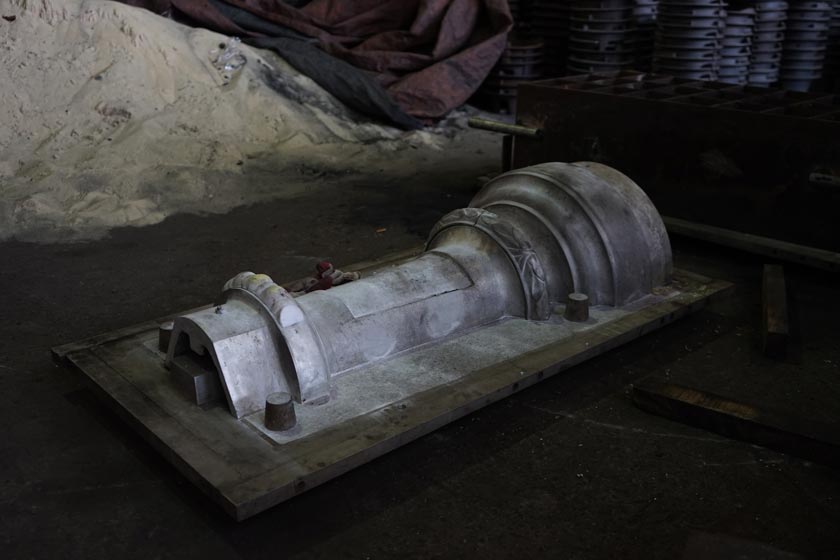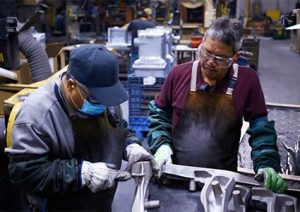Aluminum Foundry Wisconsin serves industries with casting solutions
Wiki Article
Exactly How Aluminum Foundry Adds To Advancements in Aerospace Engineering
Aluminum shops are important to advancements in aerospace engineering. They produce light-weight, high-strength components that are crucial for contemporary airplane. Through innovative spreading strategies, these shops develop complicated geometries that improve architectural stability. Additionally, the advancement of exceptional Aluminum alloys sustains the industry's concentrate on gas efficiency and sustainability. Difficulties stay in the production process. Comprehending these variables discloses the extensive impact of Aluminum on air travel's future.The Importance of Lightweight Products in Aerospace Design
As the aerospace sector remains to progress, the significance of lightweight materials ends up being significantly apparent. The need for efficiency and sustainability drives designers to prioritize the use of materials that reduce general weight without compromising architectural integrity. Lightweight materials, particularly Aluminum, play a necessary role in improving gas performance, enhancing haul capability, and boosting the general performance of aircraft.In addition, the assimilation of these products permits cutting-edge designs, allowing makers to produce even more aerodynamic shapes that can withstand extreme problems. The reduction in weight not just decreases functional expenses however also adds to a lowered ecological footprint, straightening with worldwide efforts towards sustainability in air travel.
Advanced Casting Techniques in Aluminum Foundries
Advanced casting strategies in Aluminum factories play an essential function in aerospace engineering by making it possible for the production of exact and lightweight components. Innovations in mold design and accuracy spreading processes are essential in accomplishing excellent performance and structural stability. Furthermore, the development of lightweight alloys improves the overall efficiency and efficiency of aerospace applications.Innovative Mold And Mildew Style
Cutting-edge mold and mildew design plays a necessary function in the efficiency and effectiveness of Aluminum shops, specifically within the aerospace sector. By leveraging sophisticated products and strategies, modern-day molds can be crafted to withstand heats and pressures, making sure peak performance throughout the spreading procedure. These designs usually integrate complex geometries that enable for the manufacturing of lightweight yet structurally audio parts, vital for aerospace applications. In addition, the use of computer-aided style (CAD) software application assists in exact modeling, enabling foundries to replicate and improve mold and mildew designs before physical manufacturing begins. This not just enhances the quality of cast parts however also decreases waste and preparation, bring about significant expense financial savings. Overall, innovative mold style is a keystone of progression in Aluminum Foundry technology for aerospace design.Accuracy Casting Procedures
The performance of innovative mold styles effortlessly incorporates with accuracy casting processes, which are crucial for creating high-quality Aluminum components in aerospace engineering. These procedures, including sand casting, die spreading, and investment spreading, assure the production of intricate geometries with limited resistances. Advanced methods like vacuum casting and stress pass away casting enhance the stability and surface area coating of the end products. Accuracy casting lessens product waste while making the most of the mechanical residential or commercial properties of Aluminum, crucial for aerospace applications. On top of that, employing real-time monitoring and progressed simulation devices during the spreading process enables for immediate changes, resulting in improved top quality control. Jointly, these precision casting processes position Aluminum foundries at the leading edge of aerospace technology, sustaining the industry's need for dependability and performance.Light-weight Alloy Development
As aerospace designers seek to enhance gas performance and performance, light-weight alloy development comes to be an important emphasis in Aluminum foundries. These shops utilize sophisticated spreading methods to create alloys that give exceptional strength-to-weight ratios. Developments in alloy structure, including the consolidation of aspects like lithium and magnesium, make it possible for the production of products that endure severe conditions while minimizing overall airplane weight. Techniques such as die casting and financial investment spreading assist in the precision production of intricate shapes, which are essential for aerospace applications. Furthermore, recurring research intends to maximize these alloys for improved mechanical residential or commercial properties and raised toughness. By prioritizing light-weight alloy development, Aluminum shops substantially contribute to the advancement of aerospace engineering, leading the way for much more efficient and lasting aircraft designs.
Enhancing Structural Integrity With Aluminum Parts
Aluminum components offer substantial advantages in boosting structural stability within aerospace engineering. Their lightweight nature contributes to overall effectiveness while preserving stamina, which is necessary for airplane performance. Additionally, the stress resistance residential properties of Aluminum assistance ensure the toughness and dependability of aerospace frameworks under different operational problems.
Light-weight Product Advantages
While conventional materials often compromise weight for toughness, making use of Aluminum parts in aerospace design provides significant benefits in architectural integrity. Aluminum's light-weight nature adds to overall style effectiveness, allowing for more streamlined airplane that eat much less fuel, thus boosting sustainability. The material's outstanding strength-to-weight proportion warranties that parts maintain sturdiness without adding unneeded mass. This quality cultivates improved efficiency and dexterity in trip, as well as enhanced payload capabilities. Additionally, Aluminum's resistance to deterioration extends the life-span of aerospace structures, lowering upkeep costs and enhancing safety. As producers significantly embrace Aluminum alloys, the aerospace sector experiences a transformative shift towards more effective and reliable design services that focus on both performance and environmental obligation.Stress And Anxiety Resistance Features
Although various materials have unique residential properties, Aluminum's outstanding stress resistance sticks out as a crucial consider enhancing the structural integrity of aerospace elements. This resistance plays a vital function in making certain that airplane can withstand various operational tensions, including tiredness, effect, and ecological problems. Aluminum Check This Out alloys, specifically engineered for aerospace applications, exhibit high tensile stamina while preserving lightweight characteristics, allowing engineers to create a lot more reliable frameworks - Aluminum Foundry. In addition, the capacity of Aluminum to endure cyclic loading without significant deformation adds to the durability and reliability of aerospace parts. As innovations continue in Aluminum Foundry strategies, the advancement of stress-resistant Aluminum components promises more enhancements in performance, safety and security, and performance across the aerospace industry, strengthening Aluminum's function as a preferred product in contemporary designGas Effectiveness Improvements Driven by Aluminum Innovations
As the aerospace industry looks for to improve gas performance, ingenious uses of Aluminum have actually emerged as an important remedy. Aluminum's lightweight nature notably reduces airplane weight, permitting reduced fuel intake during trip. This reduction in weight is crucial, as even small reductions can bring about substantial renovations in total gas economic situation.Advanced Aluminum alloys, developed for boosted stamina and sturdiness, enable makers to create elements that keep structural honesty while minimizing mass - Aluminum Foundry. In addition, the combination of Aluminum in airframes and engine elements facilitates boosted aerodynamics, adding to minimized drag and increased effectiveness
The fostering of Aluminum in aerospace not only fulfills the demand for fuel-efficient design but also straightens with governing pressures for reduced emissions. As these advancements proceed to evolve, they play a considerable duty in establishing new criteria for fuel effectiveness, making certain that the aerospace market can satisfy expanding environmental and economic difficulties.

The Function of Aluminum in Sustainable Air Travel Practices
The raising focus on lasting air travel techniques has actually placed Aluminum as an essential material in the pursuit for greener airplane layout. Recognized for its light-weight buildings, Aluminum significantly decreases aircraft weight, bring about reduced gas intake and discharges. Its recyclability even more enhances its sustainability profile, as Aluminum can be recycled indefinitely without loss of quality. This particular sustains a circular economic climate within the aviation field, minimizing waste and source depletion.Advancements in Aluminum alloys have actually boosted their stamina and corrosion resistance, permitting for longer service life and reduced upkeep needs. These innovations promote the advancement of extra effective aircraft frameworks, adding to general sustainability efforts. Additionally, Aluminum's thermal conductivity plays her response a vital duty in energy-efficient styles, enhancing systems such as warmth exchangers. Collectively, these features underscore Aluminum's essential function ahead of time sustainable air travel, straightening with global efforts intended at decreasing the ecological impact of flight.
Difficulties Encountered by Aluminum Foundries in Aerospace Manufacturing
While Aluminum factories play an important duty in aerospace production, they encounter significant difficulties that can influence production effectiveness and top quality. One significant challenge is the rigid quality assurance standards needed in the aerospace sector. Any kind of defect can jeopardize security and efficiency, necessitating extensive inspection processes that prolong manufacturing timelines. Furthermore, shops typically contend with fluctuating resources prices, which can influence rates and earnings. The complexity of Aluminum alloys used in aerospace applications additional complicates the production procedure, as precise solutions are essential for accomplishing preferred mechanical buildings. Proficient labor lacks impede the ability to maintain top notch manufacturing levels. Ecological guidelines impose restrictions on emissions and waste monitoring, calling for shops to invest in sustainable techniques, which can be cost-prohibitive. These variables jointly produce a landscape where Aluminum factories need to constantly adapt to meet the advancing needs of aerospace manufacturing while ensuring safety and security and compliance.Future Patterns in Aluminum Applications for Aerospace Design
With developments in innovation and increasing needs for efficiency, the future of Aluminum applications in aerospace engineering is poised for substantial improvement. The integration of innovative Aluminum alloys and compounds is expected to improve strength-to-weight ratios, bring about more fuel-efficient airplane styles. On top of that, innovations in additive manufacturing techniques will certainly allow for the manufacturing of complex Aluminum structures that were previously difficult, maximizing performance and lowering waste.
Lasting techniques will play a crucial role, with a growing emphasis on recycling Aluminum to lessen ecological influence. The aerospace sector is likely to accept smarter producing processes, such as automation and expert system, ensuring higher high quality and accuracy in Aluminum elements. Collaborations between Aluminum foundries and aerospace business will cultivate research and growth, leading the method for new applications that meet the strict needs of modern-day aerospace engineering. In general, the future looks promising for Aluminum's role in forming the skies
Often Asked Concerns
What Are the Environmental Impacts of Aluminum Manufacturing in Aerospace?
The ecological effects of Aluminum production in aerospace include significant energy usage, greenhouse gas discharges, and environment interruption. Additionally, mining procedures can lead to soil degradation and water contamination, increasing problems about sustainability and environmental balance.Just How Does Aluminum Compare to Other Products in Aerospace Applications?
Aluminum provides a distinct mix of light-weight buildings, rust resistance, and cost-effectiveness compared to other materials. Its high strength-to-weight ratio makes it specifically advantageous for aerospace applications, enhancing fuel efficiency and overall efficiency in airplane layout.What Qualifications Do Aluminum Foundry Employees Requirement for Aerospace Projects?
Aluminum Foundry employees require specialized training in metallurgy and casting techniques, together with knowledge of aerospace sector standards. Certifications in quality assurance and security methods are also crucial to ensure conformity with strict aerospace task requirements.Exist Any Security Interest In Utilizing Aluminum in Aerospace Engineering?
Security concerns relating to Aluminum in aerospace design consist of susceptibility to fatigue, anxiety, and deterioration cracks. Proper treatment and alloy choice are vital to reduce these dangers, making certain architectural honesty and overall safety in aerospace applications.How Does Aluminum Recycling Benefit the Aerospace Market?
Aluminum reusing substantially profits the aerospace industry by decreasing product prices, minimizing ecological impact, and saving power. This lasting method improves the market's effectiveness while promoting the usage of light-weight, high-performance elements in airplane production.Advanced spreading methods in Aluminum factories play an important function in aerospace engineering by enabling the manufacturing of light-weight and accurate parts. Cutting-edge mold and mildew layout plays a look at this now crucial duty in the performance and performance of Aluminum foundries, especially within the aerospace field. As aerospace designers look for to boost gas efficiency and efficiency, light-weight alloy growth ends up being a crucial emphasis in Aluminum foundries. Aluminum alloys, especially engineered for aerospace applications, exhibit high tensile toughness while preserving light-weight features, allowing engineers to make a lot more efficient frameworks. Partnerships between Aluminum shops and aerospace business will certainly promote research and growth, leading the way for brand-new applications that meet the rigorous requirements of modern-day aerospace design.
Report this wiki page